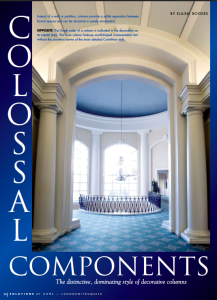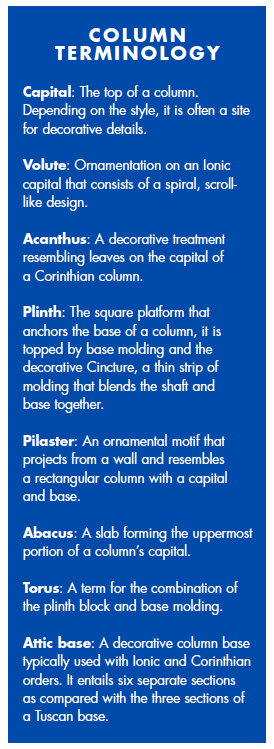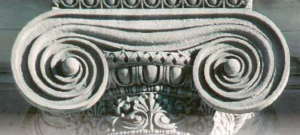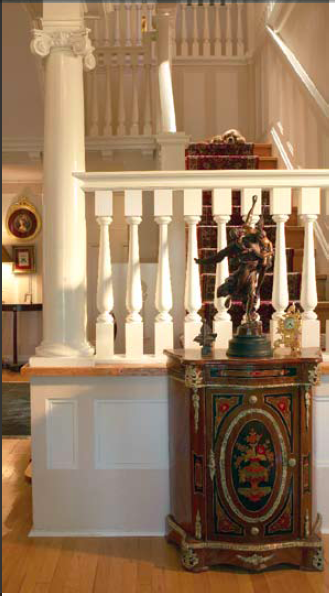Design Feature — Colossal Components
 The Distinctive, find Dominating Style of Decorative Columns
The Distinctive, find Dominating Style of Decorative Columns
By Elaine Rogers
Possessing a towering magic that has flourished through the ages, try structural columns are an architectural version of the strong, here silent type.
Frequently, they take on a supporting role, creating backdrops that quietly uplift the effects of far-more diminutive design elements. More familiar than formidable, these colossal components come smooth, square, fluted or flared, with intricacies ranging from subtly intersecting linear grooves to ornate replications of ringed foliage.
When sitting on a porch swing, gently encased in the solid comfort of short, square columns on an early-twentieth century Foursquare, this sturdy, reassuring quality is evident, but you’ll also experience it in the grand atrium of a Greek Revival structure, as tall, tapered pillars gracefully hoist the archways above.
“Columns are a classical element that have been around for thousands of years,” says Bill Baxter, a salvage specialist and design associate with Mid-Atlantic retailer Architectural Antiques Exchange. “They add a sense of history to any structure, even those that are brand new and don’t have it on their own.”
 That appeal, he adds, is stronger than ever, as builders and architects continue to use such elements in their newer creations, and many homeowners favor decorative columns in their interior settings. “There’s a comfort that comes from things that are old or look like they are,” Baxter explains. “Basically, I think people don’t want their houses to have the appearance of having just been built. … They want the appearance of historical significance.”
That appeal, he adds, is stronger than ever, as builders and architects continue to use such elements in their newer creations, and many homeowners favor decorative columns in their interior settings. “There’s a comfort that comes from things that are old or look like they are,” Baxter explains. “Basically, I think people don’t want their houses to have the appearance of having just been built. … They want the appearance of historical significance.”
Ezra Wolverton, operations manager at FineHouse, Ltd., in Maurertown, says he sees homeowners add columns when they’re building a home but also when they want to boost the star power of their garden — on a pergola, for instance. The most popular column style in Northern Virginia is the Tuscan style in a 10-inchwide, 8-foot-tall column, he notes.
To hold down costs while offering something durable to customers, FineHouse casts a composite column of polyester resin and marble dust. “We take the marble and crush it up and cast it in a mold,” Wolverton says. “The columns are very strong, very structural and have the look and feel of natural stone. The cost isn’t out of sight, and it’s very attractive.”
CELEBRATING HISTORY
Commonly load-bearing and almost always decorative, columns have a long and rich history that ranges from the classic Grecian styling of acanthus leaves on a Corinthian capital (top of the pillar) to the sleek styling of Europe’s Tuscan order.
Like many of today’s modern wonders, its origins can be traced to ancient Egyptian civilizations. The earliest styles, dating back to 2600 B.C., were oversized and narrowly spaced with carvings intended to resemble bundled reeds. Over time, the supportive aspect has remained, even as artistic and aesthetic values increased.
A mainstay in royal and monumental buildings through the ages, columns symbolize status and strength. Among the famous ruins of the Roman Empire, the pillars have remained to tell stories of the culture’s wealth, population and social structure.
KNOW YOUR GREEK
Still dominant today are three classic styles, referred to as “orders,” that stem from Greek architecture. The oldest and simplest of these is the Doric column. With 20 flutes or grooves that come to a point above, the Doric style lacks a separate base and boasts a smooth, rounded top. Developed during the seventh century B.C., it was perfected in the fifth century and, most dramatically, during the construction of the Parthenon of Athens.
 Also fluted but slightly more slender, the Ionic column evolved from the Doric style with differences that include 24 flutes instead of 20, a rounded base and scroll-shaped ornamentation at the top. The third type of classical Grecian columns is the highly decorative Corinthian style that primarily differs from the Ionic style via its olive or laurel leaf designs at the top of the shaft.
Also fluted but slightly more slender, the Ionic column evolved from the Doric style with differences that include 24 flutes instead of 20, a rounded base and scroll-shaped ornamentation at the top. The third type of classical Grecian columns is the highly decorative Corinthian style that primarily differs from the Ionic style via its olive or laurel leaf designs at the top of the shaft.
As the most popular and influential of the three, the Corinthian column appeared in the fourth century B.C. and is the most widely replicated of the styles.
Typically, a Corinthian footing is more ornate and is called an Attic base. With a classic design that involves three rows of acanthus leaves sitting directly below decorative scrolls, the elaborate capital accentuates the Corinthian’s role as the most trim and heavily adorned colonnade offerings.
Putting a more simplistic imprint on the Doric order, Romans in the sixteenth century designed what is now called the Tuscan order, streamlining the style further by smoothing out the fluting or grooves of the Grecian styles and featuring a non decorative architectural base.
DRAMATIC DETAILS
Supporting roofs, balconies and overhangs, columns are often made hollow in order to wrap around load-bearing support poles. Made of plaster, cement, wood or even high-density urethane, they promise all levels of delicate detailing and solid support.
Fiberglass, the simplest of materials for this application, withstands the effects of natural elements, while composite, made from a mixture of ground marble, fiberglass and polymer resin, has the look of stone even as it forms hollow, lightweight columns that can also be load-bearing.
 Wood is commonly considered the most versatile material choice, especially for intricate detailing on areas like fireplace surrounds. Cherry wood and mahogany are frequently favored, while American cedar also has its share of fans.
Wood is commonly considered the most versatile material choice, especially for intricate detailing on areas like fireplace surrounds. Cherry wood and mahogany are frequently favored, while American cedar also has its share of fans.
Inside a home, designers and architects say decorative columns added to a dining room or formal living room help scale down oversized furniture that might otherwise seem too large, stuffy or ornately styled for a plain room.
Replacing a plain wall, decorative columns are a solid choice for a permanent room divider, retaining the open feel while addressing the desired separation with an ornamental touch.
And in an abode without exterior columns or historic architecture suitable to the use of such classic elements, columns can still come into play with dramatic pilasters (imagine columns sliced lengthwise to fit flat against a wall) adorning formal rooms. Another option is to form fireplace surrounds with smaller, pedestal-sized pilasters.
“Even if the home doesn’t have columns as part of its original design, they work well on a portico on the side of the house or in front and also integrated into garden settings with something like a pergola,” Baxter adds.
Regardless of the material used or the size, realtors and other real estate market specialists say the addition of columns typically increases a home’s value given their prestigious history and classic architectural significance.
